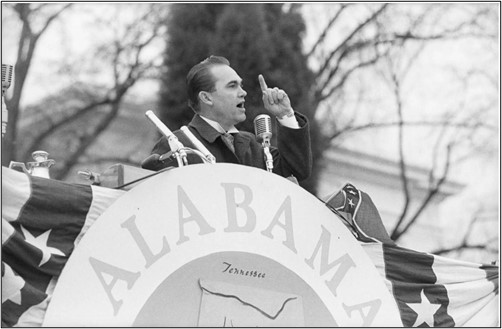Teaching with Documents: Wallace’s Defense of Segregation
Alan Singer

Alabama Governor George Wallace delivers his first inaugural address.
In Freedom’s Dominion: A Saga of White Resistance to Federal Power (Basic Books, 2002), Jefferson Cowie focused on the history Barbour County, Alabama, to document the way a deeply self-serving concept of “freedom” was used by whites to justify racist policies. It was all about their “freedom.” White freedom meant freedom from government restraints; freedom from taxes to support public institutions and services; freedom to own and use guns; and freedom to mistreat African Americans without federal intervention. White freedom, dating to the era of Black enslavement and Jim Crow segregation, equated with racism. Source:https://www.nytimes.com/2022/12/12/books/review/freedoms-dominion-jefferson-cowie.html
Sadly, fear of federal imposition on white freedom remains alive and well today and was part of the justification for the January 6, 2021 insurrection at the United States Capitol building in Washington DC and is the ideological underpinning for the attack on Critical Race Theory by Florida Governor Ron DeSantis and other conservative Republicans. When DeSantis was reelected in November 2022, he declared that his election signified “Freedom is here to stay!” Polls repeatedly show that a large majority of white voters who identify as Republican believe that there is discrimination against white people in the United States and that little or nothing needs to be done to ensure equal rights for African Americans and other minority groups.
Sources: https://www.local10.com/vote-2022/2022/11/08/is-desantis-on-path-to-remain-governor-of-florida/; https://thehill.com/hilltv/what-americas-thinking/433270-poll-republicans-and-democrats-differ-strongly-on-whether-white/; https://www.pewresearch.org/politics/2021/08/12/deep-divisions-in-americans-views-of-nations-racial-history-and-how-to-address-it/
Barbour County’s best-known native son was George Wallace, Governor of Alabama from 1963 to 1967, 1971 to 1979, and 1983 to 1987. Wallace was also a candidate for President of the United States four times, both in Democratic Party primaries and as an independent candidate. In June 1963, while Governor of Alabama, Wallace staged standing in the entrance to the University of Alabama in Tuscaloosa to block the enrollment of Black students. In defiance of a federal court order, he accused the federal government of usurping state authority in the field of education by calling for desegregation. Wallace finally backed down when the Kennedy Administration federalized Units of the 31st (Dixie) Division of the Alabama National Guard.
Source: https://archive.nytimes.com/www.nytimes.com/library/national/race/061263race-ra.html
For Black History Month, students, Black, white, Asian, and Latinx, should read texts and listen to speeches by inspiring Black authors and orators. But to understand the depth of racism in the past and today, they also need to read and understand racist texts that defended slavery and racial segregation. In his January 1963 inaugural address, George Wallace, as the newly elected governor of Alabama, issued a defiant defense of racial segregation. At the time, only fourteen percent of eligible Black citizens were registered to vote in Alabama although at least 30% of the population was Black. Poll taxes, literacy tests, and hostile registrars effectively ensured white supremacy, white freedom, in the state. Sources: https://rediscovering-black-history.blogs.archives.gov/2016/10/25/voting-rights-in-the-early-1960s-registering-who-they-wanted-to/; http://www.bplonline.org/resources/government/AlabamaPopulation.aspx
“Segregation Now, Segregation Forever” (1963)
By Alabama Governor George Wallace
A. “Before I begin my talk with you, I want to ask you for a few minutes patience while I say something that is on my heart: I want to thank those home folks of my county who first gave an anxious country boy his opportunity to serve in State politics. I shall always owe a lot to those who gave me that first opportunity to serve . . . This is the day of my Inauguration as Governor of the State of Alabama. And on this day I feel a deep obligation to renew my pledges, my covenants with you . . . the people of this great state.”
B. “General Robert E. Lee said that ‘duty’ is the sublimest word on the English language and I have come, increasingly, to realize what he meant. I SHALL do my duty to you, God helping . . . to every man, to every woman . . . yes, to every child in this state . . . I shall fulfill my duty in working hard to bring industry into our state, not only by maintaining an honest, sober and free enterprise climate of government in which industry can have confidence . . . but in going out and getting it . . . so that our people can have industrial jobs in Alabama and provide a better life for their children.”
C. “Today I have stood, where once Jefferson Davis stood, and took an oath to my people. It is very appropriate then that from this Cradle of the Confederacy, this very Heart of the Great Anglo Saxon Southland, that today we sound the drum for freedom as have our generations of forebears before us done, time and time again through history. Let us rise to the call of freedom loving blood that is in us and send our answer to the tyranny that clanks its chains upon the South. In the name of the greatest people that have ever trod this earth, I draw the line in the dust and toss the gauntlet before the feet of tyranny . . . and I say . . . segregation today . . . segregation tomorrow . . . segregation forever.”
Questions
- Who did Wallace quote on the importance of “duty”? What signal was Wallace sending to his audience by quoting him?
- What other references does Wallace make in the speech to ensure his audience understands his political point of view?
- How does Wallace propose to battle “tyranny” and defend “freedom”?
- Wallace pledged to honor “covenants with you . . . the people of this great state.” In your opinion, to who was Wallace referring? What evidence in the text supports this interpretation?
